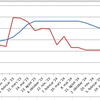22.3.2010 | 09:10
EKKI ÞARF NEINA "SÉRFRÆÐINGA" FRÁ AGS TIL AÐ SJÁ ÞETTA.........
Skuldasöfnun hins opinbera og það vandamál að rekstur hins opinbera er eins ÓÁBYRGUR og nokkur maður getur hugsað sér er eitt STÆRSTA vandamálið í alþjóðlegu viðskiptaumhverfi í dag. Þeir sem annast rekstur opinberra fyrirtækja og stofnana, í það minnsta hér á landi og örugglega á það sér hliðstæður erlendis, eru flestir gjörsamlega vanhæfir til að gegna því starfi enda hafa flestir fengið störf sín á pólitískum forsendum og sökum tengsla en ekki vegna verðleika. Menn geta sagt sér sjálfir að með Jarðfræðing sem fjármálaráðherra er ekki von á góðu. Margir héldu nú að við hefðum "toppað" vitleysuna með því að hafa Dýralækni sem fjármálaráðherra en það átti eftir að koma í ljós að ekki var Jarðfræðingurinn sem tók við af honum neitt skárri, verri ef eitthvað var. Það virðist vera að það eina sem hægt er að gera í ríkisfjármálunum, sé algjör uppstokkun á rekstri ríkisins og opinberra stofnana og að hætt verði að taka einhverjum "vettlingatökum" á forstöðumönnum/konum stofnana og fyrirtækja sem EKKI virða fjárlög.

|
AGS varar við aukningu skulda hins opinbera |
| Tilkynna um óviðeigandi tengingu við frétt | |
Flokkur: Viðskipti og fjármál | Facebook
« Síðasta færsla | Næsta færsla »
Bloggvinir
-
 annabjorghjartardottir
annabjorghjartardottir
-
 arnarthorjonsson
arnarthorjonsson
-
 skagstrendingur
skagstrendingur
-
 formula
formula
-
 reykur
reykur
-
 flinston
flinston
-
 asthildurcesil
asthildurcesil
-
 biggilofts
biggilofts
-
 bjarnijonsson
bjarnijonsson
-
 bjarnimax
bjarnimax
-
 westurfari
westurfari
-
 bjornaxelsson
bjornaxelsson
-
 bokin
bokin
-
 dagsol
dagsol
-
 einarbb
einarbb
-
 einarvill
einarvill
-
 einarorneinars
einarorneinars
-
 finnur
finnur
-
 fritzmar
fritzmar
-
 georg
georg
-
 gislim3779
gislim3779
-
 gudbjornj
gudbjornj
-
 gutti
gutti
-
 elnino
elnino
-
 manix
manix
-
 zumann
zumann
-
 gmaria
gmaria
-
 noldrarinn
noldrarinn
-
 tilveran-i-esb
tilveran-i-esb
-
 gthg
gthg
-
 gunnsithor
gunnsithor
-
 gustafskulason
gustafskulason
-
 halldorjonsson
halldorjonsson
-
 hallurhallsson
hallurhallsson
-
 hbj
hbj
-
 hallibjarna
hallibjarna
-
 heimssyn
heimssyn
-
 formannslif
formannslif
-
 diva73
diva73
-
 helgatho
helgatho
-
 helgigunnars
helgigunnars
-
 hordurhalldorsson
hordurhalldorsson
-
 ingagm
ingagm
-
 ingolfursigurdsson
ingolfursigurdsson
-
 thjodfylking
thjodfylking
-
 astromix
astromix
-
 fun
fun
-
 jensgud
jensgud
-
 ezuz
ezuz
-
 joiragnars
joiragnars
-
 johannvegas
johannvegas
-
 jaj
jaj
-
 fiski
fiski
-
 jonerr
jonerr
-
 bassinn
bassinn
-
 jonsnae
jonsnae
-
 jonvalurjensson
jonvalurjensson
-
 thjodarskutan
thjodarskutan
-
 juliusvalsson
juliusvalsson
-
 ksh
ksh
-
 kolbrunerin
kolbrunerin
-
 kristinn-karl
kristinn-karl
-
 kristinthormar
kristinthormar
-
 stinajohanns
stinajohanns
-
 keh
keh
-
 kristjan9
kristjan9
-
 magnuss
magnuss
-
 magnusthor
magnusthor
-
 odinnth
odinnth
-
 solir
solir
-
 olafurjonsson
olafurjonsson
-
 os
os
-
 pallvil
pallvil
-
 ragnar73
ragnar73
-
 rosaadalsteinsdottir
rosaadalsteinsdottir
-
 hughrif
hughrif
-
 fullveldi
fullveldi
-
 seinars
seinars
-
 nafar
nafar
-
 holmarinn
holmarinn
-
 sigurdurig
sigurdurig
-
 siggiflug
siggiflug
-
 siggith
siggith
-
 sigurjonth
sigurjonth
-
 stormsker
stormsker
-
 timannatakn
timannatakn
-
 tibsen
tibsen
-
 valdimarjohannesson
valdimarjohannesson
-
 skolli
skolli
-
 valur-arnarson
valur-arnarson
Nýjustu færslur
- HVAÐA RÁÐ ERU TIL AÐ RÁÐHERRAR FARI AÐ LÖGUM OG BÖÐLIST EKKI...
- ÞEGAR "SKESSURNAR" FARA AÐ LEIKA SÉR AÐ ELDINUM - VERÐA ÞÆR A...
- VERÐA ÞÁ "BOLABRÖGÐIN" ÚR SÖGUNNI???????
- LOSUM OKKUR ÚR NATO - SEGJUM OKKUR ÚR SCHENGEN OG SEGUM UPP E...
- OG ERU EINHVERJAR "ALVÖRU" RÁÐSTAFANIR FYRIRHUGAÐAR???????
- HAFA VERIÐ GERÐAR BREYTINGAR Á STJÓRNARSKRÁNNI OG STJÓRNSKIPU...
- ÞAÐ ER NÚ EIGINLEGA LÁGMARK AÐ RÁÐHERRA FARI MEÐ RÉTT MÁL ÞEG...
- REGLUR UM KLÆÐABURÐ Á VINNUSTAÐ - MENN EIGA BARA AÐ FARA EFTI...
- ERU "YFIRSKESSURNAR" Á ÍSLANDI KOMNAR Í "KASTLJÓSIÐ" HJÁ BAND...
- HÚN ÞARF NÚ AÐ FARA AÐ ENDURSKOÐA "FORGANGSRÖÐUNINA" HJÁ SÉR....
- ÖRLÖG HVALSINS ERU LÖNGU RÁÐIN...........
- HVAÐA "LYGI" KEMUR NÆST FRÁ ÞESSU "SKATTAÓÐA" BAKBORÐSSLA...
Færsluflokkar
- Bloggar
- Bækur
- Dægurmál
- Enski boltinn
- Evrópumál
- Ferðalög
- Fjármál
- Fjölmiðlar
- Formúla 1
- Heilbrigðismál
- Heimspeki
- Íþróttir
- Kjaramál
- Kvikmyndir
- Lífstíll
- Löggæsla
- Mannréttindi
- Matur og drykkur
- Menning og listir
- Menntun og skóli
- Pepsi-deildin
- Samgöngur
- Sjónvarp
- Spaugilegt
- Spil og leikir
- Stjórnmál og samfélag
- Sveitarstjórnarkosningar
- Tónlist
- Trúmál
- Trúmál og siðferði
- Tölvur og tækni
- Umhverfismál
- Utanríkismál/alþjóðamál
- Vefurinn
- Viðskipti og fjármál
- Vinir og fjölskylda
- Vísindi og fræði
Eldri færslur
2025
2024
2023
2022
2021
2020
2019
2018
2017
2016
2015
2014
2013
2012
2011
2010
2009
2008
2007
Heimsóknir
Flettingar
- Í dag (4.7.): 5
- Sl. sólarhring: 201
- Sl. viku: 1051
- Frá upphafi: 1894627
Annað
- Innlit í dag: 2
- Innlit sl. viku: 648
- Gestir í dag: 2
- IP-tölur í dag: 2
Uppfært á 3 mín. fresti.
Skýringar






Athugasemdir
Það eru algjörir hálfvitar sem sjá um þýðingar á fréttum hjá mogganum.
Þetta er erlenda fréttin.
-----------------------------------
BEIJING (AP) -- The International Monetary Fund warned the world's wealthiest nations Sunday to watch their surging levels of government debt, saying it could drag down the growth needed to ensure continued economic recovery.
The economic crisis is leaving "deep scars in fiscal balances, particularly in the advanced economies," John Lipsky, the IMF's No 2. official, told the China Development Forum in Beijing. He said that countries that have been going into debt to stimulate their economies should now prepare for belt-tightening steps next year.
"Policymakers should be making it clear to their citizens why a return to prudent policies is a necessary condition for sustained economic health," said Lipsky, who is the fund's deputy managing director, according to remarks prepared for the conference.
The IMF projects that gross general government debt in the G-7 advanced economies, except Germany and Canada, will rise from an average of about 75 percent of GDP at the end of 2007 to about 110 percent of GDP at end of 2014, Lipsky said.
This year, the average debt-to-GDP ratio in the wealthiest countries is projected to reach levels that prevailed in 1950 in the aftermath of World War II, Lipsky said. The ballooning of government debt also comes amid rising health and pension spending, he said.
"Addressing this fiscal challenge is a key near-term priority, as concerns about fiscal sustainability could undermine confidence in the economic recovery," Lipsky said, adding that in the medium term, large public debt could lead to higher interest rates and slower growth.
Countries should aggressively pursue reforms that will boost growth, such as the liberalization of goods and labor markets and the elimination of tax distortions, he said, though such moves on their own will be insufficient without direct measures to reduce spending.
They should also strengthen fiscal institutions in ways that could include improving tax collection and reinforcing fiscal responsibility legislation, while pursuing entitlement reforms, such as increasing the retirement age, to help in restoring finances, he said.
For the United States, Lipsky said a higher public savings rate will be required to ensure long-term fiscal sustainability.
"An increase in public saving would augment an expected rise in household saving to boost national saving and reduce the current account deficit," he said.
America's national debt -- now $12.5 trillion -- has been growing by leaps and bounds over the past decade, to the point where it threatens to swamp overall economic output. Roughly half of it is owned by global investors, with China holding the largest stake.
Japan's debt is proportionately even bigger -- about twice its GDP -- but the impact is cushioned by the fact that most is held by Japanese households.
In Europe and Japan, where there is already a high tax burden on labor, Lipsky said measures should focus on improving the targeting of social benefits and on reducing exemptions on indirect taxes.
Baldur Fjölnisson, 22.3.2010 kl. 11:00
Síðan má sjá hér hlutfall erlendra skulda af GDP og erlendar skuldir per einstakling í helstu komandi þrotabúum heimsins.
http://www.cnbc.com/id/30308959?slide=1
----------------------------------------------------
1. Ireland - 1,267%
External debt (as % of GDP): 1,267%
External debt per capita: $567,805
Gross external debt: $2.386 trillion (2009 Q2)
2008 GDP (est): $188.4 billion
2. Switzerland - 422.7%
External debt (as % of GDP): 422.7%
External debt per capita: $176,045
Gross external debt: $1.338 trillion (2009 Q2)
2008 GDP (est): $316.7 billion
3. United Kingdom - 408.3%
External debt (as % of GDP): 408.3%
External debt per capita: $148,702
Gross external debt: $9.087 trillion (2009 Q2)
2008 GDP (est): $2.226 trillion
4. Netherlands - 365%
External debt (as % of GDP): 365%
External debt per capita: $146,703
Gross external debt: $2.452 trillion (2009 Q2)
2008 GDP (est): $672 billion
5. Belgium - 320.2%
External debt (as % of GDP): 320.2%
External debt per capita: $119,681
Gross external debt: $1.246 trillion (2009 Q1)
2008 GDP (est): $389 billion
6. Denmark - 298%
External debt (as % of GDP): 298.3%
External debt per capita: $110,422
Gross external debt: $607.38 billion (2009 Q2)
2008 GDP (est): $203.6 billion
7. Austria - 252.6%
External debt (as % of GDP): 252.6%
External debt per capita: $101,387
Gross external debt: $832.42 billion (2009 Q2)
2008 GDP (est): $329.5 billion
8. France - 236%
External debt (as % of GDP): 236%
External debt per capita: $78,387
Gross external debt: $5.021 trillion (2009 Q2)
2008 GDP (est): $2.128 trillion
9. Portugal - 214.4%
External debt (as % of GDP): 214.4%
External debt per capita: $47,348
Gross external debt: $507 billion (2009 Q2)
2008 GDP (est): $236.5 billion
10. Hong Kong - 205.8%
External debt (as % of GDP): 205.8%
External debt per capita: $89,457
Gross external debt: $631.13 billion (2009 Q2)
2008 GDP (est): $306.6 billion
11. Norway - 199%
External debt (as % of GDP): 199%
External debt per capita: $117,604
Gross external debt: $548.1 billion (2009 Q2)
2008 GDP (est): $275.4 billion
12. Sweden - 194.3%
External debt (as % of GDP): 194.3%
External debt per capita: $73,854
Gross external debt: $669.1 billion (2009 Q2)
2008 GDP (est): $344.3 billion
13. Finland - 188.5%
External debt (as % of GDP): 188.5%
External debt per capita: $69,491
Gross external debt: $364.85 billion (2009 Q2)
2008 GDP (est): $193.5 billion
14. Germany - 178.5%
External debt (as % of GDP): 178.5%
External debt per capita: $63,263
Gross external debt: $5.208 trillion (2009 Q2)
2008 GDP (est): $2.918 trillion
15. Spain - 171%
External debt (as % of GDP): 171.7%
External debt per capita: $59,457
Gross external debt: $2.409 trillion (2009 Q2)
2008 GDP (est): $1.403 trillion
16. Greece - 161.%
External debt (as % of GDP): 161.1%
External debt per capita: $51,483
Gross external debt: $552.8 billion (2009 Q2)
2008 GDP (est): $343 billion
17. Italy - 126.7%
External debt (as % of GDP): 126.7%
External debt per capita: $39,741
Gross external debt: $2.310 trillion (2009 Q1)
2008 GDP (est): $ 1.823 trillion
18. Australia - 111.3%
External debt (as % of GDP): 111.3%
External debt per capita: $41,916
Gross external debt: $891.26 billion (2009 Q2)
2008 GDP (est): $800.2 billion
19. Hungary - 105.7%
External debt (as % of GDP): 105.7%
External debt per capita: $20,990
Gross external debt: $207.92 billion (2009 Q1)
2008 GDP (est): $196.6 billion
20. United States - 94.3 %
External debt (as % of GDP): 94.3%
External debt per capita: $43,793
Gross external debt: $13.454 trillion (2009 Q2)
2008 GDP (est): $14.26 trillion
Baldur Fjölnisson, 22.3.2010 kl. 11:10
Bæta við athugasemd [Innskráning]
Ekki er lengur hægt að skrifa athugasemdir við færsluna, þar sem tímamörk á athugasemdir eru liðin.